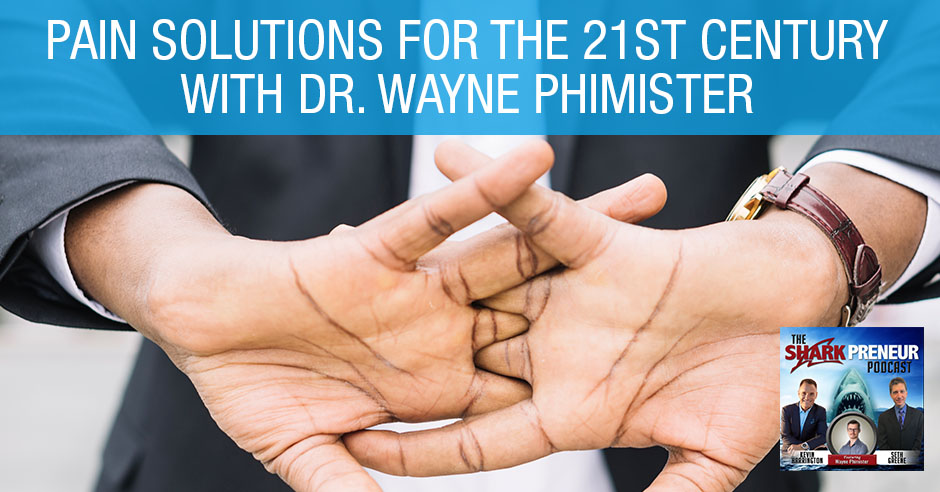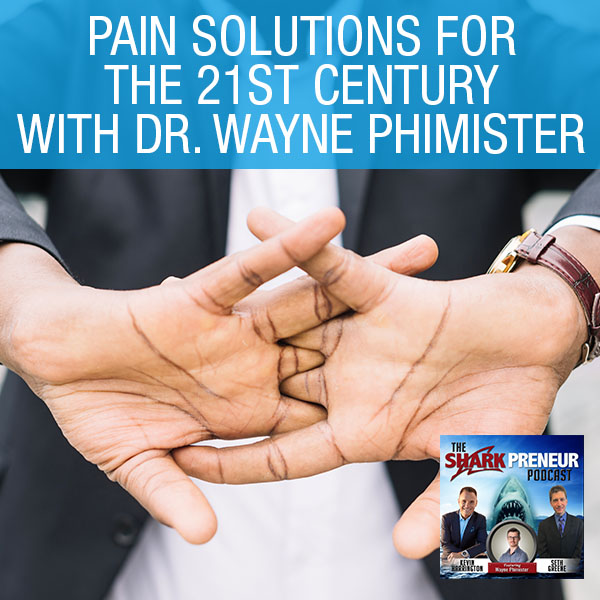
At the age of seventeen, Dr. Wayne Phimister had a fascination with science and the desire to help people. He took on the challenge, took up medicine, and decided to head down the path of becoming a medical doctor. At the end of medical school he connected with the simple task of talking with patients in the setting of an office. He was drawn to the one-to-one lognitudical care from cradle to grave of being a family doctor. Learning that some of his patients were interested in alternative medicine, he threw himself into the world of alternative treatments too and learned that there are other pain solutions and treatments for conditions other than the traditional approach.
—
Listen to the podcast here:
[smart_track_player url=”https://www.podetize.com/statsapi/www.podetize.com/wp-content/uploads/fileuploads/11-5b145ef137b51b3d1af0633e9305c43d/05/2018/eebd0600f823951f62954e0f62ef6f33.mp3″ title=”Pain Solutions For The 21st Century with Dr. Wayne Phimister” artist=”Sharkpreneur” image=”https://marketdominationllc.com/wp-content/uploads/2018/06/height_360_width_360_overlay_SharkPreneur_BEST_Wayne_Phimister.png” ]
Pain Solutions For The 21st Century with Dr. Wayne Phimister
I have a very special guest with me, Dr. Wayne Phimister. Dr Wayne, thank you so much for joining us.
You’re welcome. It’s great to be here.
It is great to have you. Dr. Wayne is a fellow podcaster over at Pain Solutions For The 21st Century. It’s the name of his show. I highly recommend listening to it. Let’s go back in time a little bit. I found that most people in the healing professions have some origin story of why they got in in the first place. How did you become Dr. Wayne?
Back at high school, I had a fascination with science and I had that inner desire to help people. It was very simple. Around the age of seventeen, I set my mind to helping people and I wanted a challenge. I ended up deciding on medicine and headed down that path. Off I went at eighteen to the University of Aberdeen in Scotland and started the journey right then.
[Tweet “I was able to do something extra for my patients. Not only were you releasing muscles but you’re releasing fascia.”]
How did you decide what your medical specialty was going to be?
Throughout medical school I was planning a career in pediatrics. However, at the very end of six years in my last month learning about family medicine, it clicked. I felt the best line of medicine for me was family medicine caring for both individuals and their families from cradle to crave. It was a heartfelt decision and turned out to be the best place to learn my vocation.
Most family doctors don’t do what you do. How did that come about from traditional family medicine to what you’re doing now?
One of the main reasons I moved from family medicine to pain management was it turned out to be a very satisfying way to help people as I was always interested in alternative methods of pain treatments. I learned patients were really interested in alternative medicines. I did a little bit of research and found 40% of the Scottish population back then in the 1990s were involved with alternative practitioners. I myself took up an interest to see why and went down the path of learning about hypnosis, Rolfing (which is a deep tissue massage therapy), Reiki (a healing type therapy), and also acupuncture. Within a month or two of finishing my family medicine training, I jumped in and studied medical acupuncture.
Dr. Wayne, you could have easily stopped there. You could have just done acupuncture and other approaches. Instead, you’ve taken it to a whole other new level and you’ve moved around the world. Talk a little bit about that journey.
From Scotland I moved to New Zealand and worked with the Natives for 6 months. From there my wife and I moved to BC, Canada where we live now. On my travels I learned about the acupuncture technique of dry needling and studied with Dr. Chan Gunn in Vancouver. Chan has a groundbreaking approach to pain that’s recognized all over Canada and around the world. I learned that when muscles get painful they are shortened and tightened, and you can treat by releasing the muscle with an acupuncture needle. I jumped into this training and I was passionate about it. Every day I was poking patients pain away. Over twelve years I gained a lot of experience and knowledge on the subject and I ended up teaching at university and I really loved doing it. The real fascinating thing for me was three years ago, I changed my technique to use medical needles versus an acupuncture one and a new world of understanding arose of why chronic pain stays locked-in in the body.
The main difference with the technique is the shape of the needle. The medical needle is hypodermic, therefore you can inject solution or medications. It’s got a cutting edge and it’s certainly not as smooth and refined as an acupuncture needle. When you inject into the body with pain, you often hear a noise of crunching or feel the resistance in the tissues to the penetrating needle. I didn’t know what this was and it’s certainly not something you were not taught in medical school. There are no lab tests nor scans to explain where this noise is coming from. I thought, “What is this resistance in the tissue?” I basically figured out that this is a fascial plane of resistance that accompanies the tightened shortened muscles. Therefore, I was able to do something extra for my patients. Not only were you releasing muscles but you’re releasing fascia too. For the last few years I’ve taken the basic technique of trigger point injections making it my own with a unique dynamic treatment formula on how to successful treat patients with chronic soft tissue pain. I now want to teach other doctors my technique where-ever they are in the globe, so I’ve created an online Trigger Point course to make this happen.

Pain Solutions: There are other ways to treat pain and other conditions other than the traditional approach.
There are the patients that you’ve been treating using this technique and then as you educate other doctors in how to do it, then there’s this giant ripple effect. You’re not just treating the patients you can physically handle, you’re now affecting patients literally all over the world by other practitioners. That is a beautiful thing. Who is the ideal practitioner to take this on? Who is your ideal client for that course?
The doctor who’s treating patients with pain, for example a sports physician who is struggling with finding answers to the chronic pain situation, a rehabilitation specialist who is trying to get the patients back to functioning and they’re struggling with the pain in the body. You’ve got medical orthopedics who focus on conservative medical management by helping patients mobilize and exercise with physiotherapy and other treatment modalities. You have family doctors who see the majority of patients with pain, but are very busy and need simple efficient treatments to help their patients. In fact rheumatologists, neurologists and neurosurgeons would all benefit from actively doing this trigger point injection technique.
For our audience who might either be physicians or who might be in chronic pain and want to take this to their physician and say, “Can you learn about this so you can do it on me?” What is the best place for them to learn more about you?
My website WaynePhimister.com is a great start. From there you can register your email and we can get back in touch with you about that training course.
Dr. Wayne, thank you so much for joining us.
You’re welcome. Thank you, Seth.
Links mentioned:
- Dr. Wayne Phimister
- Pain Solutions For The 21st Century
- Dr. Chan Gunn
- Trigger Point course
- WaynePhimister.com
About Dr. Wayne Phimister
 I trained in Aberdeen, Scotland as a General Practitioner before working in the North East of Scotland and New Zealand before settling in BC. I have worked in Agassiz for 9 years as a full serviced GP with a variety of roles including delivering babies, doing daily hospital rounds in Chilliwack, performing house calls, hospice visits and acting as medical director of 2 nursing homes for a short period of time. I taught UBC medical students and family medicine residents in the role of Assistant Clinical Professor.
I trained in Aberdeen, Scotland as a General Practitioner before working in the North East of Scotland and New Zealand before settling in BC. I have worked in Agassiz for 9 years as a full serviced GP with a variety of roles including delivering babies, doing daily hospital rounds in Chilliwack, performing house calls, hospice visits and acting as medical director of 2 nursing homes for a short period of time. I taught UBC medical students and family medicine residents in the role of Assistant Clinical Professor.
My practice is now focused on pain management in the Fraser Valley and North Vancouver where I assess and treat with trigger point injections, postural alignment correction, cognitive behavioural therapy and provide insight to the mind-body connection on how to heal from pain. I provide education and hope to those looking for solutions for chronic pain.
I now teach trigger point injections to students, residents, GPs as well as online courses to further enhance skills of doctors around the world looking for solutions for patients in chronic pain.
My qualifications are MBChB, BSc, DFFP, MRCGP DipMedAcup CCFP CAFCI CertGunnIMS FCFP.

